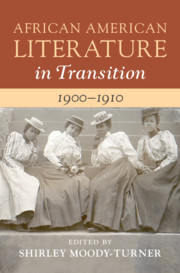Book contents
- African American Literature in Transition, 1900–1910
- African American Literature in Transition
- African American Literature in Transition, 1900–1910
- Copyright page
- Contents
- Figures
- Contributors
- Preface
- Acknowledgments
- Chronology, 1900–1910
- Introduction
- Part I Transitions in African American Authorship, Publishing, and the Visual Arts
- Part II New Negro Aesthetics and Transitions in Genre and Form
- Part III Modernist Masculinities and Transitions in Black Leadership
- Part IV Remapping the Turn of the Twentieth Century
- Chapter 10 Can the Black Subaltern Speak?
- Chapter 11 Race and Manhood in African American Representations of the Frontier
- Chapter 12 Narratives of Black and Chinese Citizenship after Plessy v. Ferguson
- Chapter 13 Black Transpacific Culture and the Migratory Imagination
- Index
Chapter 13 - Black Transpacific Culture and the Migratory Imagination
from Part IV - Remapping the Turn of the Twentieth Century
Published online by Cambridge University Press: 29 April 2021
- African American Literature in Transition, 1900–1910
- African American Literature in Transition
- African American Literature in Transition, 1900–1910
- Copyright page
- Contents
- Figures
- Contributors
- Preface
- Acknowledgments
- Chronology, 1900–1910
- Introduction
- Part I Transitions in African American Authorship, Publishing, and the Visual Arts
- Part II New Negro Aesthetics and Transitions in Genre and Form
- Part III Modernist Masculinities and Transitions in Black Leadership
- Part IV Remapping the Turn of the Twentieth Century
- Chapter 10 Can the Black Subaltern Speak?
- Chapter 11 Race and Manhood in African American Representations of the Frontier
- Chapter 12 Narratives of Black and Chinese Citizenship after Plessy v. Ferguson
- Chapter 13 Black Transpacific Culture and the Migratory Imagination
- Index
Summary
In 1899, W. E. B. Du Bois identified the rise of imperial Japan and the US colonization of the Philippines as world-historical events heralding a century defined by “the problem of the color line.” This chapter takes stock of his prophecy’s first decade, mapping the scope of a Black transpacific culture that restructured the collective imagination of African Americans’ dynamic position in a modernizing world. Japan and the Philippines exemplify two aspects of this Black transpacific culture: one that looked upward, envisioning a potential “champion of the darker races” emerging from Asia to challenge white supremacy, while the other looked downward, at the colonial territories and benighted wards of US expansion, whose benevolent uplift might provide new opportunities for African American imperial citizenship. Surveying material and speculative domains of geopolitics, military service, education, popular entertainment, and migration, the chapter shows how Black transpacific culture reoriented the imagination of Black belonging, worldliness, and destiny, recasting the horizons of the array of Black political and cultural modernisms that would set an Afro-Asian century in motion.
Keywords
- Type
- Chapter
- Information
- African American Literature in Transition, 1900–1910 , pp. 322 - 348Publisher: Cambridge University PressPrint publication year: 2021

